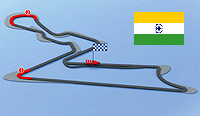


25/10/2011
NEWS STORY
 The Formula One drivers will only turn a wheel for the first time at the Buddh International Circuit on Friday morning. But although those practice laps will mark the beginning of a new learning process, the teams and drivers are far from starting from zero when they actually take to the track. Preparations for the race have been underway for nearly a year - and by race day, around one million simulations of the race will already have been completed.
The Formula One drivers will only turn a wheel for the first time at the Buddh International Circuit on Friday morning. But although those practice laps will mark the beginning of a new learning process, the teams and drivers are far from starting from zero when they actually take to the track. Preparations for the race have been underway for nearly a year - and by race day, around one million simulations of the race will already have been completed.
The process of preparing for a new race begins with the logistical challenges rather than the technical ones. Mercedes GP's travel department conducted a recce of the local area in December 2010, and made hotel reservations shortly afterwards. The logistics crew generally make a visit around nine months ahead of the race, in order to plan the layout of the garage, access routes and storage areas. In terms of technical preparations, these begin with architects' plans of the circuit. The elevation and camber provided on these are used to construct a basic track map for virtual simulation, around six weeks before the event.
This map is gradually improved as more information becomes available from the FIA and the circuit. In recent years, circuits have only been completed very shortly before the first race weekend - and the same is true for the inaugural Indian Grand Prix - which means the team cannot make a digitised map of the track. Set-up simulations, which provide the baseline settings for the car at the start of the opening practice sessions, are carried out the week before the event.
Circuit characteristics can be distinguished from a basic two-dimensional map. Factors such as downforce levels, braking duty and g-force loadings are all a function of the circuit's geometry, and basic simulations will provide a direction for those parameters. Initial simulation suggests that the cars will spend around 65% of the lap at full throttle, with the longest full throttle period of 14.5 seconds, between turns three and four. The cars will exceed 175 mph at three points around the lap, while the fastest corner is expected to be turn 12, which is expected to be taken at 155 mph. The maximum g-loading around the circuit is expected to be 4.0 G, at Turns 5, 9 and 11.
The basic nature of the track map means that the simulator can only be used for basic familiarisation with the circuit, because the track map is not detailed enough to include information such as bumps and kerbs which influence set-up tuning. The teams will generally complete around 100 laps (nearly two race distances) in the simulator, programmed with a variety of fuel loads and grip levels, to ensure as many possible scenarios as possible are covered. In addition to using the driver-in-the-loop simulator, the team conducts strategy simulations to analyse as many race outcomes as possible. By race day, we will have performed around one million iterations of the potential race, which are used to inform decisions about how to approach qualifying and the race itself.
Like with other circuits, drivers must be familiar with the KERS deployment schedule (when KERS is deployed to the greatest performance advantage around the circuit), the DRS zones and also the pit-entry and exit lines, for speed limiter activation and deactivation. In terms of learning the circuit, the drivers will conduct their usual track walk on Thursday to inspect it on foot, and potentially note specific signs and markings that they will need to be aware of when in the car. In terms of learning the circuit, this is an ongoing process through the weekend, as grip levels increase, and the team structures its practice programmes to give the drivers maximum time to familiarise themselves with the intricacies of the layout.
The Buddh circuit has similarities to Turkey, with a long main straight and a very long, sweeping corner (Turns 10 and 11) that resembles the triple-apex Turn 8 in Istanbul. However, while Turn 8 was taken with an average corner speed of 165 mph, in India the corners are expected to be taken at 105 mph (Turn 10) and 130 mph (Turn 11) respectively. The lap time and speed will be very much dependent on the grip level achieved by the Pirelli tyres on the new asphalt surface. A lap time of 1:25.000 would correspond to an average lap speed of 135 mph, while a lap time of 1:30.000 would equate to an average lap speed of 127 mph.